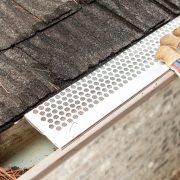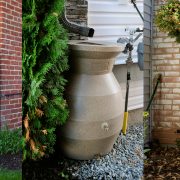Why We Recommend Adding Leaf Screens
It was a dark and stormy night. At least that’s how I understand every hack novel starts. However, in my case it was true.
My wife and I had just retired for the evening, an evening filled with rain and wind. It was one of those rare storms San Diego gets every few years, and one that few people want to venture outside.
I was channel surfing and had just settled on a good movie when I heard the distinct sound of water splattering on concrete. That wet sloppy noise that catches you attention and tells you something’s not quite right.
I reluctantly crawled out of bed thinking, “now what?”. I pulled back the curtain, turned on the outside light and was greeted with a gushing waterfall a few feet from where I was standing. My gutters were overflowing. I knew that it meant my gutter was clogged up. I began running causes through my mind as I sought a reason they could possibly be clogged. Having no trees anywhere near my house, I was baffled.
Then the inevitable. I had to decide whether to put up with the noise or fix the problem. Since I’m a light sleeper, putting up with the noise was not an option.
I located a step ladder, but no raincoat. I figured that it would only take a minute so I’d just use my bathrobe. Not my best idea. I jumped through the deluge and set the step ladder below the downspout. In the short time it took me to do this, I was already wet, freezing, and angry. I reached up into the rain gutter and grabbed a mushy glob. I looked at it in disbelief. In my hand were strands of grass, some feathers, and some string. What??
After a hot shower I lay in bed thinking. The only way that junk could have got into the gutter was during the summer when the birds were nesting. The birds must have been collecting the grass strands and some got discarded on the roof. When the rain came it washed these strands into the gutter where it accumulated over the downspout outlet. Were the feathers and the goop possibly a dead bird?
Then I realized that I’d have been in a pickle if I lived in a two story house. I would have had to wait until morning to unclog the gutter. Fortunately I have two story ladders, but I wondered what would have happened if one of my customers had this had happened to them.
Well, they would have to wait until morning and then try to locate a ladder if they didn’t already own one. It would have to be an extra long ladder because many newer houses have ten foot ceilings. What if the homewoner wasn’t comfortable with heights? They’d have to call a handyman, roofer, or San Diego Rain Gutters to come over to clear out the clog. Hopefully, I could get someone to come out in the rain, since the storm was supposed to last for three days. How much would that cost?
That’s when I realized that I must educate people as to the importance of adding leaf screens, even if they don’t have trees nearby. Like many things, we don’t realize we need them until it’s too late.
In the following weeks I asked my installation crews to collect samples of debris they find in rain gutters. I wanted to do an informal test. The results were interesting. Most of the debris consisted leaves, and that was to be expected. However, the next most frequent items found were children’s balls and toys. The next were bird nests and related debris followed by one decomposing rat.
I decided that all my estimators should include a quote for installing leaf screens on our new gutters. It would be much less expensive for our clients since the gutters were new and didn’t need cleaning beforehand. The ladder, equipment and personnel were already on the job so the travel time and set up time was eliminated.
What is the best kind of leaf screen? I’ll cover that at another time.


